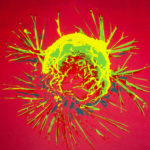My Thyroid Cancer
My husband and I were intrigued to discover that this week’s New England Journal of Medicine has articles on both of our cancers!
Larry is doing active surveillance for prostate cancer, the article that’s making headlines right now, but I had thyroid cancer, the topic of a terrific review article in the very same issue.
My diagnosis back in 1993 was rather archaic by today’s molecular standards – the doctor for whom I provide genetic counseling services saw me from across a room and said, matter-of-factly, “Hello Ricki. You have a thyroid tumor.”
A glance in the mirror revealed the egg-shaped bulge that had escaped my notice, for mammograms and Pap smears were as far as my personal cancer surveillance went at that time.
A few days later, a Friday, an endocrinologist stuck 7 needles in my neck for biopsies, assuring me that “99% of these are benign.” When he called before 8 am the following Monday morning, I knew right away something was up – bad medical news isn’t given right before a weekend.
That something was papillary thyroid cancer. Three weeks later, a surgeon removed the tumor, but while probing the other side of my gland, noted an ominous bulge there too. He sent a sample to pathology, which soon came back with a label of follicular cancer, and out came the entire gland. I was fortunate. Papillary and follicular cancers are highly treatable; anaplastic and medullary thyroid cancers are the dangerous ones. But even metastatic thyroid cancers have new targeted treatments.
A month later, I returned to the medical center to drink radioactive iodide to mop up any remaining cancer cells, administered by a doc who had had his own thyroid removed, so the exposure couldn’t harm him. Then I was marooned in a corner room for 3 days, with my food slid in on a tray like I was a prisoner. I was released with instructions to stay away from my kids and to flush three times, lest I contaminate them with glow-in-the-dark iodide. The manuscript I’d been working on during my isolation, for FDA Consumer, had to be stashed in the garage for a month to decontaminate.
A few years later I was excited to take my first recombinant DNA-based drug, thanks to my lack of a thyroid. In order to detect residual thyroid tissue, one must go completely hypothyroid – stay off the replacement hormone for a few weeks. But that makes you cold – and I have another condition – cold-induced urticaria and anaphylaxis – that makes exposure to the cold deadly. So I got a shot in the tush of Genzyme’s Thyrogen, a recombinant form of thyroid-stimulating hormone (TSH). If I produced thyroid hormone in response, then a smidgeon of the gland lurked. I related the experience for The Scientist circa 1999. I was happy to avoid the weeks of being bloated, bitchy, and freezing.
So here’s what I learned about my ex-cancer from the NEJM review article:
• I had a common type of thyroid cancer (papillary, 84%) and a rare one (follicular, 2%).
• From 1975 through 2009 the number of thyroid cancer diagnoses in the U.S. tripled due to detection of smaller lesions with improved imaging technologies. Yet recent identification of a non-invasive, indolent form of thyroid nodule that doesn’t need to be removed will likely lower the incidence, following the trend for active surveillance for some prostate cancers and breast ductal carcinoma in situ.
• The driver mutations behind the various guises of thyroid cancer are now known, revealing distinctions in gene expression, signaling, and clinical characteristics. Biggies are BRAF and Ras.
• Exome sequencing has found papillary thyroid tumors to have very few mutations and copy number variants compared to other cancers.
• A risk factor for papillary thyroid cancer is exposure to ionizing radiation – which I certainly had during the 5 years I wore orthodontic braces. I recall a lead shield over my ovaries, but not my neck. Radiation-linked thyroid cancers typically have translocated chromosomes that lead to fusion oncogenes, but they have little if any effect on mortality. So that’s cool.
• Tests now track gene expression and oncogenes and tumor suppressor mutations in the thyroid tissue.
• If I had the cancer today, I probably wouldn’t need the radioiodide therapy following surgery, nor the shot of Thyrogen.

One final note on thyroid cancer: after surgery, forever, do not eat soy products in the morning. They block the absorption of the replacement thyroid hormone. Many magazines tout the value of soy without realizing that many women are hypothyroid and take low doses of the hormone. I learned the hard way to stay away from my morning soy sausages – the endocrinologist thought my cancer was back.



[…] Source: My Thyroid Cancer […]